
Acacia acanthoclada, commonly known as harrow wattle, is a species of flowering plant in the family Fabaceae and is endemic to southern continental Australia. It is a low, highly branched, spreading and spiny shrub with wedge-shaped to triangular or egg-shaped phyllodes with the narrower end towards the base, and spherical heads of up to 30 flowers, and linear, spirally-coiled pods.
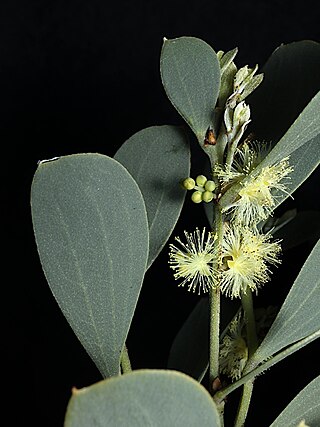
Acacia alpina, commonly known as alpine wattle is a species of flowering plant in the family Fabaceae and is endemic to alpine and subalpine regions of south-eastern continental Australia. It is an erect or spreading shrub or tree with egg-shaped or broadly egg-shaped phyllodes with the narrower end towards the base, flowers arranged in 1 or 2 racemes in the axils of phyllodes, each with cylindrical to oblong, usually pale yellow flowers, and thin-walled, gently curved or coiled pods 30–80 mm (1.2–3.1 in) long.

Acacia pravissima, commonly known as Ovens wattle, Oven wattle, wedge-leaved wattle and Tumut wattle, is a species of flowering plant in the legume family Fabaceae. It is an evergreen shrub native to Victoria, the South West Slopes and Southern Tablelands of New South Wales, Australia.
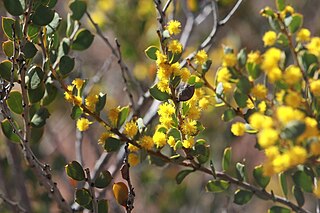
Acacia acoma is a species of flowering plant in the family Fabaceae and is endemic to inland ares of south-western Western Australia. It is an erect, spindly, open or spreading shrub with variably-shaped, often narrowly oblong phyllodes, flowers arranged in spherical heads, usually arranged in pairs in leaf axils, and strongly curved or spirally coiled pods up to 15 mm (0.59 in) long when expanded.
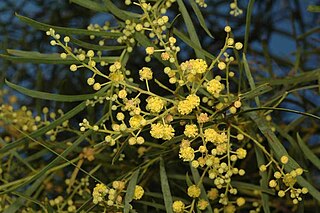
Acacia aestivalis is a species of flowering plant in the family Fabaceae and is endemic to the south-west of Western Australia. It is a bushy shrub or tree with linear to narrowly lance-shaped phyllodes, the narrower end towards the base, racemes of 5 to 11 spherical heads of golden-yellow flowers, and glabrous, papery to thinly leathery pods.

Acacia amblygona, commonly known as fan wattle or fan leaf wattle, is a species of flowering plant in the family Fabaceae and is endemic to continental Australia. It is a sprawling, sometimes prostrate shrub with sharply-pointed, lance-shaped, tapering phyllodes, golden-yellow flowers arranged in a spherical head of 10 to 18 in the axils of phyllodes, and curved, coiled or twisted pods up to 70 mm (2.8 in) long.

Acacia amblyophylla is a species of flowering plant in the family Fabaceae and is endemic to an area near Shark Bay in the north-west of Western Australia. It is a bushy shrub or tree with a dense crown, many suckers, lance-shaped phyllodes with the narrower end towards the base, golden-coloured flowers arranged in spherical heads each of 24 to 26, and broadly linear to narrowly oblong pods up to 200 mm (7.9 in) long.

Acacia ampliceps, commonly known as salt wattle or spring wattle, is a species of flowering plant in the family Fabaceae and is endemic to the north-west of Australia. It is a large, bushy shrub or small tree with often pendulous branches, pendulous, linear to lance-shaped phyllodes, white to cream-coloured flowers arranged in spherical heads, and pods up to 115 mm (4.5 in) long.

Acacia anceps, commonly known as Port Lincoln wattle or the two edged wattle, is a species of flowering plant in the family Fabaceae and is endemic to coastal areas of south-western Australia. It is a bushy, spreading shrub with glabrous branchlets angled at the ends, elliptic to lance-shaped phyllodes with the narrower end towards the base, spherical heads of 50 to 130 golden-yellow flowers, and narrowly oblong pods up to 60 mm (2.4 in) long.

Acacia anthochaera, commonly known as Kimberly's wattle, is a species of flowering plant in the family Fabaceae and is endemic to Western Australia. It is a rounded shrub or tree with narrowly linear phyllodes, racemes of 4 to 9 spherical heads of bright light golden flowers, and narrowly oblong, papery pods up to 85 mm (3.3 in) long.

Acacia aristulata, also known as Watheroo wattle, is a species of flowering plant in the family Fabaceae and is endemic to a restricted area in the south-west of Western Australia. It is a shrub with narrowly oblong to wedge-shaped phyllodes, spherical heads of creamy-white flowers, and coiled to twisted pods up to 60 mm (2.4 in) long.

Acacia sclerophylla, commonly known as the hard-leaf wattle, is a shrub of the genus Acacia and the subgenus Plurinerves and is endemic to southern parts of Australia.

Acacia trulliformis is a shrub of the genus Acacia and the subgenus Plurinerves that is endemic to an area of south western Australia.

Acacia aculeatissima, commonly known as thin-leaf wattle or snake wattle, is a species of flowering plant in the family Fabaceae and is endemic to south-eastern continental Australia. It is usually a prostrate shrub with sharply pointed, needle-shaped phyllodes, flowers arranged in up to 3 more or less spherical heads of 15 to 25 flowers, and linear, papery pods up to 60 mm (2.4 in) long.

Acacia alcockii, also known as Alcock's wattle, is a species of flowering plant in the family Fabaceae and is endemic to South Australia. It is a bushy shrub with narrowly elliptic to lance-shaped phyllodes with the narrower end towards the base, and racemes of 5 to 11 spherical heads of pale yellow flowers, and oblong pods.
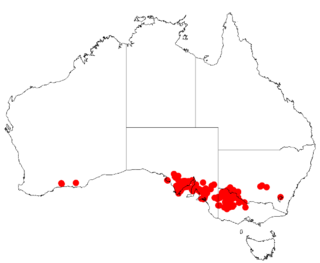
Acacia halliana is a shrub belonging to the genus Acacia and the subgenus Phyllodineae that is native to parts of south eastern Australia.
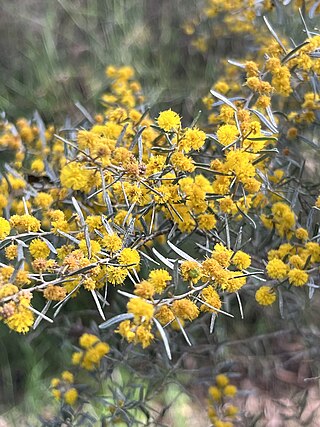
Acacia wilhelmiana, commonly known as dwarf nealie, Wilhelmi’s wattle and mist wattle, is a shrub belonging to the genus Acacia and the subgenus Plurinerves native to the mallee region of central and eastern Australia.

Acacia quornensis, commonly known as Quorn wattle, is a shrub belonging to the genus Acacia and the subgenus Phyllodineae native to southern Australia.

Acacia ruppii, commonly known as Rupp's wattle, is a shrub belonging to the genus Acacia and the subgenus Phyllodineae native to eastern Australia. It is listed as endangered in the Environment Protection and Biodiversity Conservation Act 1999.

Acacia simmonsiana, commonly known as Simmons wattle or desert manna wattle, is a shrub belonging to the genus Acacia and the subgenus Phyllodineae native to south eastern Australia.





















